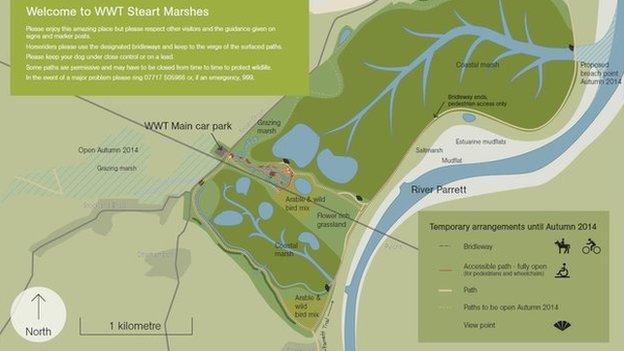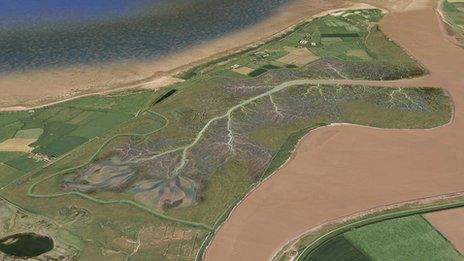Steart Peninsula's £21m wetland habitat opens
- Published
.jpg)
Some 400 hectares have been flooded at the Steart Peninsula in the £21m project
Part of a wetland habitat created with £21m of public money has opened along the Somerset coast.
The Environment Agency has flooded about 400 hectares (988 acres) of the Steart Peninsula, near Bridgwater and built flood defences for nearby homes.
About three miles (5km) of paths on the site have been opened with another five miles (9km) set to be ready by autumn.
Most of the site will be underwater so the paths only cover a third of the site and around the perimeter edge.
'Brilliant resource'
The new habitat is owned by the Environment Agency and is being managed by the Wildfowl and Wetlands Trust (WWT).
Tim McGrath from the WWT said: "In a few years' time not only will it be a brilliant resource for birds but it's also an important resource for fish. When the tide comes in, lots of fish spread themselves out across the salt marsh and feed.
"Salt marsh is a very valuable habitat - we get large numbers of roe deer across the site which are quite happy feeding out on the marshes and we also get brown hares."
The habitat creation is to compensate for the loss of existing salt marsh and mudflats through rising sea levels and the construction of coastal flood defences.
The government has an obligation to meet these targets and could face legal proceedings if it fails to create enough new coastal wetlands.
The Environment Agency has also said if the existing sea defences remained in place they would have been breached at some point and farmland would have become completely unusable.

The red section near the car park has open and more of the paths will be open by Autumn
Although the land will be flooded it can still be used at certain times of the year for grazing livestock.
The project has won local support from the parish council.
But the MP for West Somerset and Bridgwater, Conservative Ian Liddell-Grainger opposed the plans claiming it was a waste of public money and valuable farmland had been lost.
Councillor Dick Best represents Steart at Otterhampton Parish Council and runs Steart Residents Group.
He said: "I think the people of Steart have more to gain from the development of conservation areas, it will make the houses more attractive to people of a certain persuasion and that will hopefully promote viability of the community."
- Published8 March 2012

- Published5 July 2010